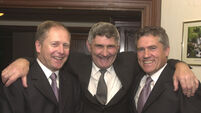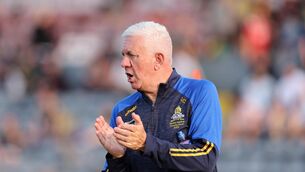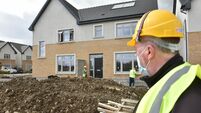Players warm to Gaelic Park
The Richie Bennis-managed 2007 selection defeated the 2006 side by 6-9 to 4-11. But the occasion was as noteworthy for the showcasing of the vastly enhanced facility — described by Bennis as an ‘earth pitch’ when he first played there with the Munster hurlers in 1969 — as the fact that the weather was arguably the coldest that any inter-county teams previously experienced at home or abroad.
The temperature was close to zero but it was the wind-chill factor which made it so unpleasant for the players and a crowd of less than a thousand (with light snow falling overnight). To be fair, while the standard of play in the first half wasn’t very exciting, 2006 manager Brian Cody argued that criticism of the teams would be unwarranted specifically because of the weather.
“It was bitterly cold, it was very hard to get the hands around the hurley and to get warmed up. But, we had some great hurling and some great scores,’’ he commented. Bennis pointed out that when the players went into the dressing-room at half time ‘they were still cold.’
Gaelic Park has been redeveloped at a cost of $3m and the stadium is shared with Manhattan College, who contributed half of the finance which went into laying the new pitch (also lengthened and widened) and installing the floodlighting system. Understandably, it’s a source of pride both for the New York Board and the GAA at home and Nickey Brennan was pleased that the reaction all round was so encouraging. Having experienced the venue himself as a player, he talked excitedly about its potential for developing the games in America as well as the value of establishing regional centres of excellence in Ireland. “We’re going to be rolling out these over the next couple of years. We’re committed to spending €30m plus on these types of facilities and the Prunty-type field as well.
“There was very little grass here and it meant the field was unplayable on occasions, not just for GAA but Manhattan College who we share the ground with. Now matches are guaranteed and they can go ahead at night. There are no more adult games in Van Courtland Park across the way, they are all played here. Teams can turn up in the evening having come from New Jersey and other places a good distance away and be guaranteed the pitch is playable.
“The other thing that has happened here is that kids’ finals are all played here. Lots of kids at their level of sport cannot aspire to playing in a stadium. That’s a big plus for the GAA. Not alone are we thinking about it at home but we are targeting to put in a good number over the next three years. The technology is changing all the time, so we want to make sure we get it right. You are probably talking in the order of between one and a half and two million euro when you put in decent floodlighting, the pitch and a fence around it.”
Colleges teams would be obvious beneficiaries of floodlit grounds with synthetic surfaces similar to the one in Gaelic Park (very different from Croke Park, which is essentially a sand-based surface strengthened by artificial grass). “It can be very hard to get club pitches to play colleges games on at this time of the year, but if you had a number of these around the country you’d be absolutely guaranteed that they would available all the time,’’ said Brennan. “In the future, you can take it that we be playing games at home on this type of surface, including championship games at certain levels. It makes sense.”
Bennis commented: “It was impressive, and more important, the players were very impressed. They were very happy with the pitch and the lights were no problem. But you couldn’t be sure because the match wasn’t played at a very fast pace. I’d say it has a future at home.”
James Young, one of the replacements on the tour, agreed, saying: “it’s something they should be looking at it.’’ And, while he was on the losing side, he said he had been ‘chuffed’ to be picked as captain. “It was a mighty honour being from Laois,’’ he said.
Andrew O’Shaughnessy had a slight reservation, explaining: “the surface was good, you just have to get over the ball more, it’s a fine set-up. You can’t use the normal ‘jab’ lift, I wouldn’t say you’d play competitive hurling matches on it yet. Maybe the game would have to be played that bit slower.’’
All-Ireland referee Diarmuid Kirwan needed to keep active to avoid being frozen over.
Scorers for 2007 Allstars: S. Molumphy 1-3; O. Moran 1-2; J. Mullane, E. Brennan, M. Walsh and A. O’Shaughnessy 1-1 each.
2006 Allstars: E. Kelly 2-4 (1-1 frees); S. McGrath and J. Young 1-2 each; T. Griffin 0-2; A. Kerins 0-1.
B. Murray (Limerick); M. Kavanagh (Kilkenny, capt.), D. Fanning (Tipperary); A. Kearney (Waterford), T. Browne (do), T. Walsh (Kilkenny); M. Walsh (Waterford), D. O’Grady (Limerick); J. Mullane (Waterford), O. Moran (Limerick), S. Molumphy (Waterford); A. O’Shaughnessy (Limerick), E. Brennan (Kilkenny).
Subs: N. Ronan (Cork) for Brennan and M. Fitzgerald (Limerick) for Kearney.
D. Óg Cusack (Cork); E. Murphy (Waterford), JJ Delaney (Kilkenny); S. Hickey (Limerick), R. Curran (Cork), K. Rossiter (Wexford); S. McGrath (Tipperary), D. Lyng (Kilkenny); A. Kerins (Galway), J. Young (Laois), T. Griffin (Clare); E. Kelly (Tipperary), M. Comerford (Kilkenny).
Sub: E. McGrath (Waterford) for Comerford.
D. Kirwan (Cork).
Note, teams were 13-a-side, after a few players were ruled out.













